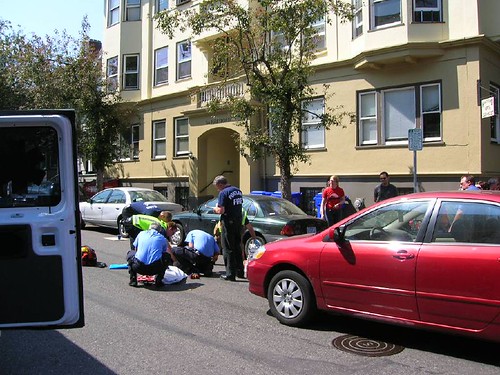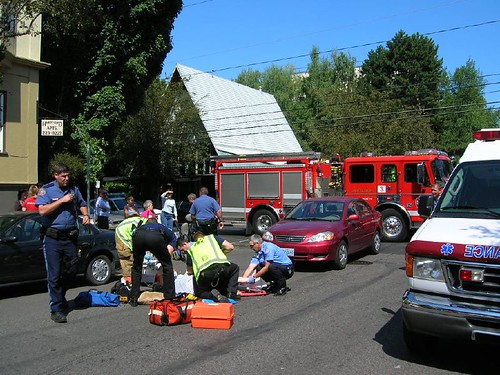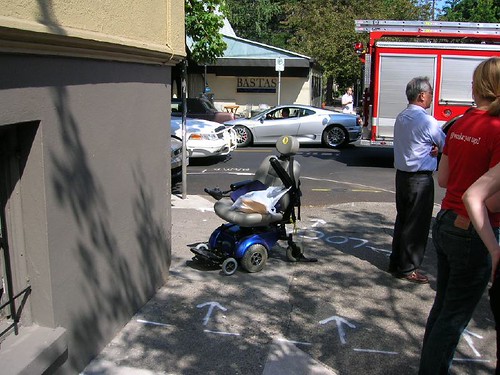One of my NW Portland neighbors took these pictures of the aftermath of an auto/powered-wheelchair collision at NW 21st and Flanders. In a post to the neighborhood listserv, he questions whether increasing the auto intensity of NW Portland (with a new parking structure) is a good idea.
My question is having just re-signed NW 21st to 20mph, what else can we do to make it safer and avoid these kinds of accidents?
One of my NW Portland neighbors took these pictures of the aftermath of an auto/powered-wheelchair collision at NW 21st and Flanders. In a post to the neighborhood listserv, he questions whether increasing the auto intensity of NW Portland (with a new parking structure) is a good idea.
My question is having just re-signed NW 21st to 20mph, what else can we do to make it safer and avoid these kinds of accidents?
Sorry, we don’t have any word on the condition of the victim.



17 responses to “The Bigger Vehicle Wins”
Posting signs specifying speeds and right only are worthless unless they are enforced.
When was the last time the Police Bureau was ticketing in NW?
And how about a traffic light at 22nd & Everett?
Is the city too cheap?
My question is having just re-signed NW 21st to 20mph, what else can we do to make it safer and avoid these kinds of accidents?
Take down the signs and redesign the street to slow traffic to 20 mph or less. Make 20 the speed only daredevils will go instead of the speed grandma feels safe at. That means narrower lanes, speed bumps, rougher road surface, low tree cover over the street. Mid-block pedestrian crosswalks with islands.
I live near there and sometimes bike home via that spot. I’m going west on Flanders when I cross 21st. It’s really a bad spot because of all the cars parked near the intersection. There’s virtually no way to see when cars are coming and I’d guess that the cars can’t see peds or bikes either. Didn’t they just remove some parking in the area because of a fatal accident a while back? On the grander scale, how do you make intersections safe and still allow street parking?
Take down the signs and redesign the street to slow traffic to 20 mph or less. Make 20 the speed only daredevils will go instead of the speed grandma feels safe at.
I agree. In our system however, you have to establish the speed limit before you can engineer for it. So having the speed at 20mph is now an opportunity to push for the engineering changes!
And how about a traffic light at 22nd & Everett? Is the city too cheap?
The neighborhood has been trying for a 4-way stop there, and can’t even get that.
JK: Many people confuse speed and safety – they are NOT THE SAME: A sure way to get people to slow down is to have babies crawling around in the street. But is isn’t safe. Now look at some other things that will slow traffic and increase accidents:
Ross Williams Says: That means narrower lanes,
JK: That means less time to see objects about to step into traffic and an increase in accidents. Also an increase in hitting parked cars and head on collisions.
Ross Williams Says: speed bumps, rougher road surface,
JK: That’s it Ross, punish the innocent along with the guilty. Good progressive principal.
Ross Williams Says: low tree cover over the street.
JK: Trees make it harder to keep watch on sidewalk action that might suddenly enter the street. Their added visual clutter makes it harder to spot people. They also block “eyes on the street” from second story (and up) windows. Their blocking of street lights will increase the crime rate. Another good progressive idea.
Ross Williams Says: Mid-block pedestrian crosswalks with islands.
JK: How about having pedestrians look both ways before crossing and while crossing. This will prevent many pedestrian accidents. I keep seeing people see that it is clear then never look again all the way across the street.
Thanks
JK
That’s it Ross, punish the innocent along with the guilty. Good progressive principal.
I don’t see either speed bumps or rougher road surface as punishment of anyone. The idea is to design the road so that people will drive at the posted speed, but not over it.
Many people confuse speed and safety – they are NOT THE SAME
No, they aren’t – you can drive slowly and still be driving unsafely. But you can’t go 40mph on a local street and still be driving safe. And there is a huge difference between being hit by a car going 15 mph (bad bruises) and 25 mph (likely dead).
That means less time to see objects about to step into traffic.
Only if people don’t slow down. If you are driving slower you will have just as much time to see objects(sic) about to step into traffic. I presume by “objects” you mean pedestrians, animals and small children.
How about having pedestrians look both ways before crossing and while crossing.
You don’t walk much do you? Crossing an intersection means looking a lot more than “both” ways. The largest danger is from turning cars who ignore the pedestrian’s right-of-way. Thus the idea of mid-block crossings. But those crossings can also slow traffic if properly designed.
What’s your objection to getting traffic speeds down to their posted level?
And how about a traffic light at 22nd & Everett? Is the city too cheap?
“The neighborhood has been trying for a 4-way stop there, and can’t even get that.”
Unbelievable! And the bigwigs in this city talk
about being pedestrrian-oriented.
BTW, I heard there have been a lot of car accidents there.
The four intersections where 20th and 22nd intersect Everett and Glisan have relatively high accident rates.
The issue is that drivers on Everett and Glisan have a two-block, one-way raceway to try to beat the next traffic light. A 4-way stop would presumably help this.
But PDOT maintains that there is insufficient cross-traffic to warrant a 4-way stop. The exact quote is “we don’t use stop signs to regulate speed.”
“we don’t use stop signs to regulate speed.”
Okay, how about a fountain or statue? Cheaper than a traffic light, smaller than a traffic circle (and therefore more easily adaptable to narrower ROW) and has a similar effect as a traffic circle to slow vehicles.
The best example in town is the fountain in the park blocks on SW Main between SW 3rd and 4th. Traffic routinely slows to the speed limit to go around it, but there is plenty of room and the curves are gentle enough to accommodate buses and fire trucks.
For those who haven’t seen it, you can glimpse it through the trees using this Google Map.
– Bob R.
Bob,
You’re talking about the Elk statue. I’d love to see these types of traffic calmers everywhere, they’re functional and beautiful. But my guess is they’re much more expensive than a traffic light, so not likely to happen anytime soon.
Well, when I said “cheaper than a traffic light” I didn’t mean something in the scale or historic gravitas as the Elk statue.
There actually are vendors of medium-to-large scale authentic stone fountains (marketed usually to wealthy estates) with reasonable prices for “stock” designs.
– Bob R.
Using public art work as traffic calming is a great idea. You might even find private money to pay for it or do an LID with local property owners.
Having moved here 10 years ago from back East, I find many things about Portland transportation and traffic odd, confusing and inefficient.
Two that come to mind in the context of this post:
1) the city allows cars to park right up to a corner, thereby severely limiting visibility to cross traffic (this is not the norm in other cities I have visited);
2) Conflicting messages result when the stop-on-a-dime-the-minute-a-pedestrian-steps-off-the-curb culture meets the pedestrian-should-look-both-ways-and-proceed-with-caution culture. The first culture prevails in California and more or less elsewhere on the West Coast. The latter prevails back east and in many other parts of the world. Portland has many transplants and, frankly, without concerted education to change well-established habits, confusion will reign.
Ross Williams Says:
“I don’t see either speed bumps or rougher road surface as punishment of anyone. The idea is to design the road so that people will drive at the posted speed, but not over it.”
Are you serious? No really, when I, or you, or somebody goes over most speed bumps at the speed limit, they realize (if they pay attention) that they’re getting shocks replaced much soon. Probably if one wants to keep their car in a “SAFE” operating condition within 1-5000 miles sooner than they would otherwise.
That means because of speed bumps (and other bad road conditions) someone is obviously being punished by spending money sooner, and possibly more, than would otherwise have been spent. It means less time getting somewhere and more time maintaining the vehicle.
I don’t know about you, but one of the reasons I don’t drive much is because I don’t want to spend extra hours maintaining the necessities of an automobile any more than I do.
How you can say their is no punishment related to speed bumps is rather illogical and I find it someone offensive.
I guess when kids get a nice firm wooden paddle on the behind that isn’t punishment either. Just “reconditioning”.
hmpf.
I’m done ranting. That one just rather offended me.
Speedbumps are a retrofit. They are only used when a street was designed incorrectly in the first place. Either the road was too wide, or the street parking missing, or the trees gone. Maybe it was a fine street for 2-way traffic, but was converted to one way, but was too wide for that conversion and traffic speeds through.
Either way, it’s not the solution. The solution is to fix the conditions that make a person comfortable driving that speed in the first place.
If speed bumps are the solution, one could argue that potholes are too. Street design is the important condition for safe streets. And streets designed well need no speed bumps.